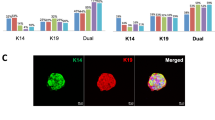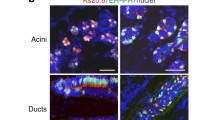Summary
Examination of estrogen-responsive processes in cell culture is used to investigate hormonal influence on cancer cell growth and gene expression. Most experimental studies have used breast cancer cell lines, in particular MCF7 cells, to investigate estrogen responsiveness. In this study we examined an ovarian cancer cell line, BG-1, which is highly estrogen-responsive in vitro. This observation, plus the fact that the cells are of ovarian rather than mammary gland origin, makes it an attractive alternative model. 17β-Estradiol, epidermal growth factor, and insulin-like growth factor induced proliferation of BG-1 and MCF7 cells. Viability was dependent on these growth factors in BG-1 cells, but not in MCF7 cells. Therefore, we examined the differences between these two cell lines with respect to estrogen and growth factor receptors. BG-1 cells have twice as many estrogen receptors as MCF7 cells, and BG-1 cells have higher insulin-like growth factor-1 and epidermal growth factor receptor levels than MCF7 cells. This may also explain why BG-1 cells proliferate 56% more robustly in serum and show more serum dependence in culture. In both BG-1 and MCF7 cells, epidermal growth factor receptor number is low (<20 000/cell), while insulin-like growth factor-1 receptor level was highest in estrogen receptor positive cell lines. For example, insulin-like growth factor-1 receptor was higher in BG-1 and MCF7 cells than in estrogen receptor negative cells (HeLa>MDA-MB-435>HBL100). In conclusion, BG-1 cells are an excellent model for understanding hormone responsiveness in ovarian tissue and an alternative for examining estrogen receptor-mediated and insulin-like growth factor-1/epidermal growth factor/estrogen cross-talk processes because of their sensitivity to these factors.
Similar content being viewed by others
References
Caron de Fromentel, C.; Nordeux, P. C.; Soussi, T., et al. Epithelial HBL-100 cell line derived from milk of an apparently healthy woman harbours SV40 genetic information. Exp. Cell Res. 160:83–94; 1985.
Chomczynski, P.; Sacchi, N. Single step method of RNA isolation by acidic guanidinium thiocyanate-phenol-chloroform extraction. Anal. Biochem. 162:156–159; 1987.
Clinton, G. M.; Rougeot, C.; Derancourt, J., et al. Estrogens increase the expression of fibulin-1, an extracellular matrix secreted by human ovarian cancer cells. Proc. Natl. Acad. Sci. USA 93:316–320; 1996.
Couse, J. F.; Curtis, S. W.; Washburn, T. F., et al. Analysis of transcription and estrogen insensitivity in the female mouse after targeted disruption of the estrogen receptor gene. Mol. Endocrinol. 9:1441–1454; 1995.
Dickson, R. B.; Lippman, M. E. Estrogenic regulation of growth and polypeptide growth factor secretion in human breast carcinoma. Endocr. Rev. 8:29–43; 1987.
DuPont, W. D.; Page, D. L. Menopausal estrogen replacement therapy and breast cancer. Arch. Intern. Med. 151:67–72; 1991.
Geisinger, K. R.; Kute, T. E.; Pettenati, M. J., et al. Characterization of a human ovarian carcinoma cell line with estrogen and progesterone receptors. Cancer 63:280–288; 1989.
Gey, G. O.; Coffman, W. D.; Kubieck, M. T. Tissue culture studies of the proliferative capacity of cervical carcinoma and normal epithelium. Cancer Res. 12:264–265; 1952.
Iacobelli, S.; Scambia, G.; Natoli, V., et al. Estrogen stimulates cell proliferation and the increase of a 52,000 dalton glycoprotein in human breast cancer cells. J. Steroid Biochem. 20:747–752; 1984.
Ignar-Trowbridge, D. M.; Pimentel, M.; Parker, M. G., et al. Peptide growth factor cross-talk with the estrogen receptor requires the A/B domain and occurs independently of protein kinase C or estradiol. Endocrinology 137:1735–1744; 1996.
Ignar-Trowbridge, D. M.; Pimentel, M.; Teng, C. T., et al. Crosstalk between peptide growth factor and estrogen receptor signaling systems. Environ. Health Perspect. 103:35–38; 1995.
Kato, S.; Endoh, H.; Masuhiro, Y., et al. Activation of the estrogen receptor through phosphorylation by mitogen activated protein kinase. Science 270:1491–1494; 1995.
Katzenellenbogen, B. S.; Kendra, K. L.; Norman, M. J., et al. Proliferation, hormonal responsiveness, and estrogen receptor content of MCF-7 human breast cancer cells grown in the short-term and long-term absence of estrogens. Cancer Res. 47:4355–4360; 1987.
Korach, K. S. Estrogen action in the mouse uterus: characterization of the cytosol and nuclear receptor systems. Endocrinology 104:1324–1332; 1979.
Laidlaw, I. J.; Clarke, R. B.; Howell, A., et al. The proliferation of normal human breast tissue implanted into athymic nude mice is stimulated by estrogen but not progesterone. Endocrinology 136:164–171; 1995.
Long, L.; Rubin, R.; Baserga, R., et al. Loss of the metastatic phenotype in murine carcinoma cells expressing an antisense RNA to the insulin-like growth factor receptor. Cancer Res. 55:1006–1009; 1995.
Luster, M. I.; Pfeifer, R. W.; Tucker, A. N. The immunotoxicity of natural and environmental estrogens. In: Dean, J. H.; Luster, M.; Munson, A. E., ed. Immunotoxicology and immunopharmacology. New York: Raven Press; 1985:315–326.
Pastan, I. Regulation of cellular growth. Adv. Metab. Dis. 8:7–16; 1975.
Reddy, K. B.; Yee, D.; Hilsenbeck, S. G., et al. Inhibition of estrogen-induced breast cancer cell proliferation by reduction in autocrine transforming growth factor α expression. Cell Growth Differ. 5:1275–1282; 1994.
Richards, J. S. Maturation of ovarian follicles: actions and interactions of pituitary and ovarian hormones on follicular cell differentiation. Physiol. Rev. 60:51–89; 1980.
Seshadri, R.; McLeay, W. R.; Horsfall, D. J., et al. Prospective study of the prognostic significance of epidermal growth factor receptor in primary breast cancer. Int. J. Cancer 69:3–27; 1996.
Soule, H. D.; Vasquex, J.; Long, A., et al. A human cell line from a pleural effusion derived from a breast carcinoma. J. Natl. Cancer Inst. 51:1409–1416; 1973.
Sporn, M. B.; Todaro, G. J. Autocrine secretion and malignant transformation of cells. N. Engl. J. Med. 303:878–880; 1980.
Steinberg, K. K.; Thacker, S. B.; Smith, S. J., et al. A meta-analysis of the effect of estrogen replacement therapy on the risk of breast cancer. JAMA (J. Am. Med. Assoc.) 265:1985–1990; 1991.
van der Burg, B. Sex steroids and growth factors in mammary cancer. Acta Endocrinol. 125:38–41; 1991.
Webster, N. J. G.; Resnik, J. L.; Reichart, D. B., et al. Repression of the insulin receptor promoter by the tumor suppressor gene product p53: a possible mechanism for receptor overexpression in breast cancer. Cancer Res. 56:2781–2788; 1996.
Zhang, R. D.; Fidler, I. J.; Price, J. Relative malignant potential of human breast carcinoma cell lines established from pleural effusions and a brain metastasis. Invasion Metastasis 11:204–215; 1991.
Author information
Authors and Affiliations
Rights and permissions
About this article
Cite this article
Baldwin, W.S., Curtis, S.W., Cauthen, C.A. et al. BG-1 ovarian cell line: An alternative model for examining estrogen-dependent growth in vitro . In Vitro Cell.Dev.Biol.-Animal 34, 649–654 (1998). https://doi.org/10.1007/s11626-996-0015-9
Received:
Accepted:
Issue Date:
DOI: https://doi.org/10.1007/s11626-996-0015-9




